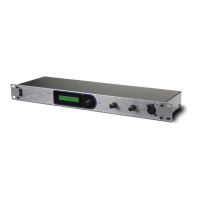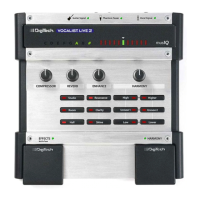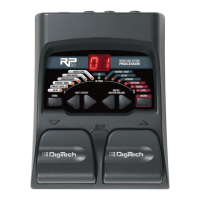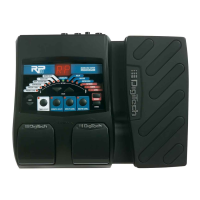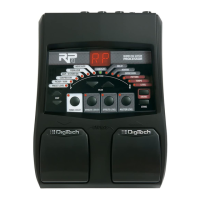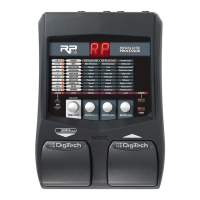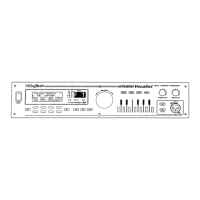
Do you have a question about the DigiTech STUDIO VOCALIST and is the answer not in the manual?
| Brand | DigiTech |
|---|---|
| Model | STUDIO VOCALIST |
| Category | Computer Hardware |
| Language | English |
Information on proper power connection and grounding for safety and unit protection.
Guidelines and warnings for safe operation, handling, and electrical hazards.
Cautionary note regarding the internal lithium battery and its replacement.
Details of the product warranty terms, conditions, and limitations.
Explanation of the controls, indicators, and features on the front panel.
Details of the input/output jacks, MIDI, and footswitch connectors on the rear panel.
Diagrams and instructions for various audio signal routing setups.
Diagrams and instructions for integrating the device with MIDI equipment.
Guide on adjusting input and output levels for optimal signal quality.
Tips for achieving optimal audio input for accurate pitch detection.
How to input musical context for automatic harmony generation.
Explanation of different harmony modes like Chordal, Scalic, and Vocoder.
Using softkey buttons to select and modify harmony variations.
How pre-defined styles streamline the parameter editing process.
Overview of menu navigation and controls for editing parameters.
Details on Edit, Soft Keys, Data Wheel, Arrow, Store, and Exit buttons.
Adjusting vocal characteristics for male or female harmony voices.
Adding subtle pitch variations to humanize harmony voices.
Applying realistic pitch modulation to harmonies for realism.
Simulating pitch bending into notes for a live vocal feel.
Adding delay to harmony voice onsets for a more human sound.
Adjusting wet/dry balance, voice levels, and stereo panning.
Attaching different pre-programmed harmony styles to programs.
Modifying existing or creating new custom harmony styles.
Fine-tuning specific harmony notes for detailed control.
Procedures for naming user programs and harmony styles.
Instructions for saving edited programs and custom styles.
Displays the current software version number of the unit.
Access to MIDI channel assignments and configuration settings.
Assigning MIDI channels for system, vocoder, and harmony control.
MIDI options for selecting key, chord root, and harmony style.
Remapping MIDI CC messages to control Studio Vocalist parameters.
Remapping incoming MIDI Program Change messages to internal programs.
Defining keyboard zones for triggering Vocoder notes.
MIDI control for song selection, mapping, and step sequencing.
Configuring MIDI control for song step direction and sequencing.
Transmitting programs, songs, and settings via MIDI System Exclusive.
Clearing user data and restoring factory default settings.
Reconfiguring the functions of the DigiTech FS300 footswitch.
Adjusting LCD contrast and enabling/disabling interval editing.
Using the onboard synthesizer for cueing or auditioning programs.
Adjusting audio parameters like Ess Sensitivity and Output Mode.
Instructions for playing and interacting with the device's demonstration songs.
Guide to creating new songs from sections and musical steps.
Modifying individual musical steps within a song section.
Procedures for naming songs and their individual arrangement sections.
Ordering song sections to define the playback sequence.
How to transpose songs to different musical keys.
Explains the concept of diatonic harmonies conforming to scales.
Details the differences and applications of Scalic and Chordal harmony types.

